 |
surfresearch.com.au
history
: streaks and slugs
|
streaks and slugs
1971 - 1974
| home | catalogue | history | references | appendix |
 |
surfresearch.com.au
history
: streaks and slugs
|
| Mark Warren and McCoy Twin Fin 1,
Narrabeen, 1971 Photograph : Uncredited Surfing World, April 1979. Volume 27 Number 6 page 34. Originally printed in Surfing World, 1971. |
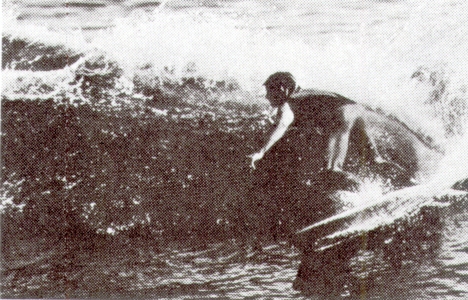 |
|
Dual fin
Dimensions5'4 ' x 20 1/2'' 'x 3 1/2" (1501b. surfer) Outline Smooth entry nose with no hip to hinder water flow, running running into a straight drag free rail rear of centre. Wide tail with rounded corners for smooth manouvering. Profile Flat plaining surface for rear 2/3 with moderate rise toward the tip. Again smooth entry, rapid release. Cross Section Soft low rails predominate with hard edges only at tail. Bottom is flat to concave through the centre and glat (sic) at the tail, with a little cushion up front. Some surfers may find a small V in the tail helpful for manouvering. Thickness is carried right through to the tail area, with just a hint of S in the deck. Fins small 6"-7". Placement is most critical. Riged (sic) Surfing Characteristics |
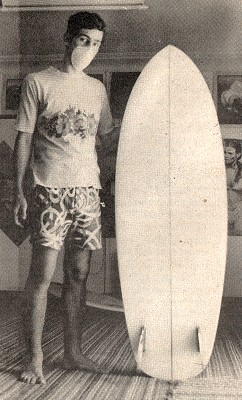 |
|
Semi-Gun
Dimensions6' 4" x 18" x 3" (1401b. surfer) Outline Generally a diamond outline with width and hip forward of centre. Acceleration straight behind hip. Narrow round tail. Pointed nose for greater penetration. Profile Soft entry nose rocker running into a 180 deg. straight. Cross Section Low rails throughout, however they are not hard. Three stage bottom - Flat under nose section, running through a concave centre to a large V in the tail. Even thickness throughout with very little S. Fin Single centre fin 6"-7" deep. Rigid with no flex, situated on tail. Surfing Characteristics Best suited to medium to large waves of delicate form. |
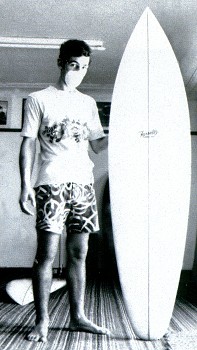 |
|
Big Wave
Design
Dimensions 7' 8" x 18" x 3 1/4'' (Built for Ted Dumuran, a 150 lb. Hawaiian) Outline Continual flowing curve form nose to tail. No straight section in the rail. Nose and tail are evenly balanced having a nose bias of only one inch. The small round tail allows tight smooth manouvering. Profile Large nose rocker running into a 180 degree flat extinding for just under two thirds of the waterline. The V in the tail has the effect of letting the rail line rise to the tail taking away the crankiness usually associated with long flats. Cross Section A very even thickness assures good balance and free running. Rails are full in shape, for good running ability yet have'a very definite edge throughout the whole length of the board which keeps all manouvering positive. Again we have a three section bottom with a large V in the tail, which has the same effect as tail rise without any of the latter's associated drag and stalling characteristics. Fin Situated on the tail. |
 |
| This time he's back
into the angled fins. The board is 5'3" long, 21 1/2" wide and has a 12" back. Scott is not suggesting that this board is any better than the twin fins the main thing he's interested in is trying to take the thing a little further. Paul Wright rode the board at Narrabeen on a small bumpy day and said that it came around faster and bites in well and said that he definitely felt like he was surfing on his backhand.  Tracks #5 Design, February 1971, page 10. |
 |
| 1971
Tracks #7 April Cover: Cyclones (Ida and Dora). Film: Sea of Joy by Paul Witzig. The Perfect Contest. NSW Championships Centrefold: MP footage that became part of The Morning Of The Earth. Design: Speed Boards. |
 |
| Advertising: Waxmate by Surf
Research, circa 1971. Tracks 1971, page 26. Distributors Wholesale BRISBANE: phone Hohensee Surfboards 91 1494 QLD. GOLD COAST: Hohensee Surfboards 2158 Gold Coast Highway, Miami 4220. N.S.W. NORTH COAST: Surf Research PO Box 44 Bangalow 2479. SYDNEY: Surf Research phone 919 4580 MELBOURNE: Surf Research phone 98 7325 TORQUAY: Surf Research c/o Post Office Torquay 3228 W.A.: Sommot PO Box 101 Subiaco 6008. Phone 25 6676. Send
25c for climatised purple square bar to Surf Research,
P.O. Box 44
Bangalow. N.S.W. 2479 |
 |
| 1972
Fins Unlimited: an evolving system
Surfing like everything else is a constantly evolving medium. During the past 6 years of surfing's evolution, Fins Unlimited has perfected fin systems that have opened new areas of the wave. After all, the fin is the key. It holds you in trim, creates a pivot point for turning and affords directional stability and speed. And what seems more logical than being able to interchange foil design, outline, depth and the flexibility of your board's fin to wave conditions, as well as adjusting fin position forward and aft for fine performance tuning. For a fin system as variable as the ocean environment, insist on Fins Unlimited, the variable interchangeable fin system. Cheer Critchlow #6 4A surfer designer has plugged into the evolution of Fins Unlimited. Fins Unlimited PO Box 375-F Encinitas California 92024 (???) 753-8847 Surfer August 1972 v13n3 page 2. |
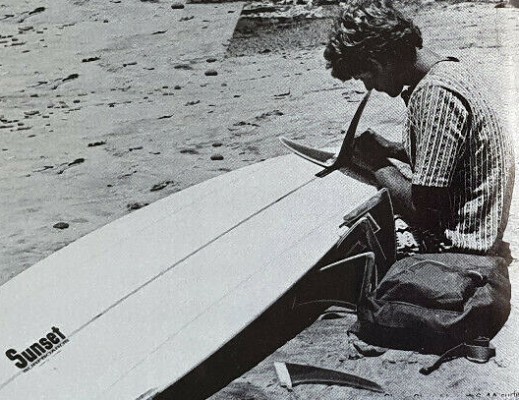 |
| Tracks # 23 August 1972
Cover: Lots of surfing Contents/Letters: Page 3 features a goofy-foot on a hollow right hander holding a leg-rope with his trailing hand. Interview: Glen Richie Kevin Platt Massage Jack McCoy: Summer in Hawaii John Witzig: Fitting out a Kombi van Sounds: Buffy Sainte-Marie Design: Terry Fitzgerald, Timmy Rogers Backyard Board Builders Honeycomb boards by Jick Mebane |
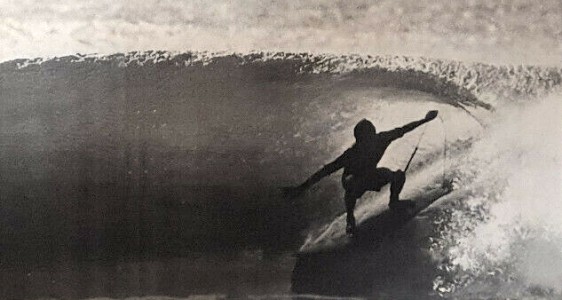 |
| 1972
Tracks #24 September
Cover: Summer Design - the winter that nearly wasn't. 1972 NSW Schoolboys Championships Interview: Robbie Dick Building Tips Conservation Summer Design: Kevin Platt, Donnie Alcroft, Darryl Dell, Fly, Bill Cilia, John Arnold, Pat Morgan, Klemm Bell, Cordingly. Interview: Lindsay Bjerre (Tamam Shud) Album Reviews: Aztecs Live at Sunbury, Marc Bolan, Manfred Mann, Al Kooper. Film Review : The Islands |
 |
|
Robert
Conneely Surf Shop
2/152 Campbell Parade Bondi Beach Ph 30-1457 Illustrated: McCoy, Spirit of the Sea, Brad Mayes, Hayden, Lightning Bolt, McTavish. Also available : Tom Hoye (W.A.) San Juan, Kenn Surfing. - Tracks January 1973, page 24. |
 |
|
Surfblanks 7 Perak Street Mona Vale 2013 Phones: 997-2014; 919-5319. Exit
Shaper Tedium
Surfblanks has a brand new seven foot blank, it's probably the fastest shaping blank in the industry. Everybody knows that a shaper has to put a lot of time into his surfboards if he wants each one to really work in the water. Surfblanks thinks that this time should be spent on the finer-details that make or break a good design. If the shaper has to spend up to'75%. of this time hacking away at a fat bloopy blank shape, chances are by the end of the day his boards are not looking as clean as they did this morning. It's very obvious too that there have been major changes in surfboard design in the last few months. |
 Blanks available in lengths of
5, 6, 7, 8 and 9ft. The 7ft is available in standard or
gun blank.
Tracks #4 January 1973, page 24. |
Page 5.
News and Opinions: Legropes.
Leg-ropes
have come in for their fair share of criticism recently.
For example:
December 1972 issue of Tracks when John Witzig wrote ". ..or
else you have a leg-rope in which case you're stupid".
As two
South-East coast surfers who have used leg-ropes in surf up
to 8' (and over?) we would like to come to the defence of
leg-ropes.
Admittedly
leg-ropes are out in BIG surf.
In order to
give this issue a fair hearing we have compiled a list of
what in our opinion are the advantages and disadvantages of
leg-ropes.
Firstly the
advantages:
Likelihood
of long swims to retrieve board all but done away with;
board doesn't get washed onto rocks or into outcoming
surfers, therefore less dings all round; danger to swimmers
and other surfers diminished greatly and hopefully a
reduction in the tension that exists between the public and
surfers, concerning the danger of swimmers being hit by an
out of control surfboard; less time spent retrieving board
therefore more waves to be had; less chance of :rips, etc,
taking your board out to sea and finally having the
assurance that a long swim is not necessarily imminent gives
the surfer the encouragement to attempt more radical
manoeuvres.
Not wanting
to seem prejudiced against those so-called "hotties" who
don't wear leg-ropes we now put forward the leg-ropes'
disadvantages:
possibility
of rope ripping into board; rope can get tangled around leg,
arm, neck, etc and thus cause bodily harm though we must say
such occurrences are, to our knowledge, extremely rare and
there is also a school of thought that feels that leg-ropes
can cramp or hinder a surfer's style from the psychological
angle.
It seems so
obvious to us and we hope to John Witzig from the above
arguments that the advantages of a properly fitted leg-rop
outweigh the disadvantages and we would like to say to all
those surfers who don't wear leg-ropes that's OK with us as
it means that while you're swimming for your board we can
have those waves you're missing.
Geoff and
Brian,
Lakes
Entrance.
| Image
right: Rick Neilsen into leg-ropes. Tracks,
March 1973, page 5. |
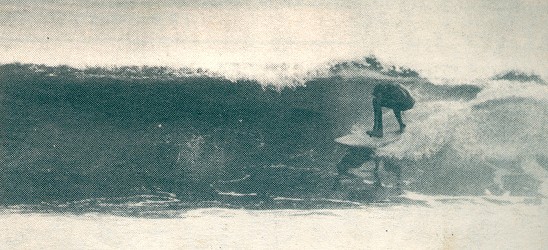 |
| 1972
Keel
Fin a long base shallow depth, 12" x 5", fin usually
fitted to a plus 7 ft gun pintail shape. Emphasis was on high speed stability and increasing length of turns, particularly in long walls. for example Bells Beach. Pat Morgan Surfboards designs for Wayne Lynch and Nat Young. See #336. Example on display Yamba Hotel, Yamba NSW. Reported by Ken Grieves, with thanks. Film : Crystal Voyager -features Nat Young riding an 8ft Pat Morgan Surfboards Pintail, green laminate with long base Keel fin. Morgan
also experimented with the Keel fin in a Twin
fin format. |
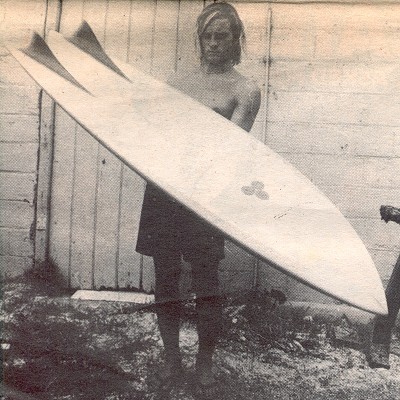 |
| 1972-1973
The SLSA contines to use the hollow plywood paddleboards
for competition and rescue work.
Image
right: Knight: History of SLS Tasmania (2006) page ? |
 |
| Tracks #35 August 1973 Dion surfboard blanks: 4" thick 22" wide and in lengths of 8ft 3", 7ft 8", 7ft 2", 6ft 4" and 5ft 9". Wallace Surfboards: For Sale  John Witzig: The Eclipse of Brookvale, page 6. |
 Page 26: Howard Owen got this great water shot of Keith Paull when all those south ground swells were around a couple of weeks ago. How far can a lip throw? |
| Tracks #38 November 1973
Cover: Tubes - George Greenough photograph Articles: Tubes- George Greenough, Peter Crawford, Colin Smith, Ron Ware, Baddy Treloar, Bob McTavish North Shore Makaha Bali Hang-gliding Tony Edwards- Cosmic tube art Page 27 Worth Catching- O'Neill Webbed Gloves Design: George Greenough’s Spoon kneeboard Peter Crawford Slab Geoff McCoy on swallowtails and boards for Hawaii. Advertisements: Harmony Surfboards, Kirra, featuring Keith Paul and Michael Peterson. Wade, Van Straalen, Morning Star, McGrigor, and McCoy Surfboards Films: A Winter’s Tale, Crystal Voyager |
Keith Paull - Tight and Secure
with Surf Cord
 Photo: Keith Paull with Surf
Cord, Burleigh Heads
|
Page 26 Delux Cord $7
 Surf Plug $1.50 Surf Cord 6ft and Under $5.50 Surf Aids Surf Cord PO Box 88 Byron Bay 2481 |

| home | catalogue | history | references | appendix |